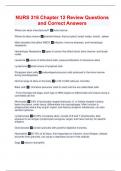NURS 316 Chapter 12 Review Questions
and Correct Answers
Where are wbcs manufactured? ✅bone marrow
Where do wbcs mature ✅lymphoid tissue: thymus gland, lymph nodes, tonsils , spleen
Main disorders that affect WBCS ✅infection, immune diseases, and hematologic
neoplasms
Hematologic Neoplasms ✅types of cancer that affect blood, bone marrow, and lymph
nodes
Leukemia ✅cancer of white blood cells, cause proliferation of cancerous wbcs
Lymphoma ✅solid tumors of lymphoid cells
Pluripotent stem cells ✅undeveloped precursor cells produced in the bone marrow
during hematopoiesis
Normal range of wbcs in the body ✅4,100-10,900 cells per microliter
Blast cells ✅- Immature precursor cells for each cell line are called blast cells
- From the blast cell stage, each type of WBC begins to differentiate and mature along a
committed cell line
Monocytes ✅3-8% of leukocytes; largest leukocyte; U- or kidney-shaped nucleus;
leave circulation, enter tissue, differentiate into macrophages. Main function is
phagocytosis where they engulf, ingest, and destroy antigenic substances, can also
secrete cytokines
Lymphocytes ✅20-35% circulating wbcs, consist of B and T lymphocytes, after
exposure to an antigen lymphocytes recognize, target, and have memory for specific
antigens
Granulocytes ✅contain granules with powerful digestive enzymes,
Neutrophils ✅60-70% of all wbcs, first responders to infection, short lifespan, release
enzymes from granules, can cause a respiratory burst of free radicals
Segs ✅mature neutrophils
, Bands ✅immature neutrophils
Bone marrow releases immature neutrophils when ✅mature supply in circulation is
exhausted
Shift to the left ✅high number of bands in circulation indicated by a lab test
Macrophages ✅function within the innate immune system and are the first responders
in defense against an antigen
Purulent exudate ✅contains dead neutrophils, infectious material, and cellular debris
Eosinophils ✅released during allergic reactions and parasitic infection, have granules
that contain chemical mediators and enzymes, 1-6% of all WBCS but numbers rise
during an allergic reaction
Basophils ✅rise in response to infection, granules that have histamine, prostaglandin,
leukotrines, and heparin
Leukocytosis ✅increase in the number of white blood cells, over 11,000 UL
Leukemoid reaction ✅Leukocytosis w/ higher increase, 50,000 microliters plus,
increase of myelocytes, metamyelocytes, and promyelocytes
Leukopenia ✅low WBC count, lower than 4,000
Most common type of WBC affected in leukopenia ✅neutrophils
Neutrophilia ✅neutrophil predominance in WBC count, neutrophil count above 7,000
CBC with differential ✅complete blood count with differential, measures total RBCS,
hemoglobin, hematocrit, platelets, total wbcs, and percentage of each WBC present
Neutropenia ✅lack of sufficient number of neutrophils, most common type of
leukopenia, fewer than 1,500, increases susceptibility to infection and diminishes signs
of inflammation
Common causes of neutropenia ✅infections, medications, vitamin deficiencies,
diseases of the bone marrow, radiation therapy, hypersplenism, etc.
Monocytic leukocytosis ✅total WBC count greater than 11,000 UL primarily caused by
a monocyte count above 800 UL




